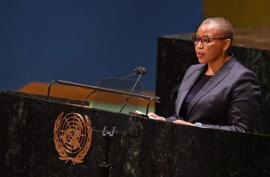Asia Pacific Tourism Poised For Unprecedented Growth, Projected to Reach Over Two Trillion US Dollar In International Spending And Almost Five Trillion US Dollar In Domestic Travel By 2029 - Travel And Tour World
Thursday, June 26, 2025

The Asia Pacific (APAC) region is set to become the global tourism leader by 2029, with projections indicating that international travel spending will soar to $2.5 trillion, and domestic tourism will reach $4.3 trillion. This monumental growth reflects the APAC region’s increasing influence on global travel trends. With a projected compound annual growth rate (CAGR) of 7% for outbound travel, the APAC region is poised to not only dominate the international tourism market but also reshape global travel dynamics in the coming years. This transformation is being driven by several key factors, including the region’s growing digital presence, an evolving traveler behavior, and a surge in experiential travel.
One of the most significant factors contributing to APAC’s tourism boom is the region’s embrace of digital technology. By 2029, it is expected that a staggering 75% of travel bookings across the region will be made online, marking a significant increase from current levels. The rise of online travel platforms and digital travel agents has made it easier for travelers to book trips, plan itineraries, and secure accommodations with a few clicks. In addition, mobile-first planning has become a dominant trend, with more consumers opting to research and plan their trips using mobile applications and websites.
The digital transformation is not limited to travel booking. Social media platforms, especially TikTok, have become major sources of influence for travelers. Studies indicate that over 40% of travelers are influenced by digital content when making travel decisions. This shift has given rise to new trends, including travel inspired by viral TikTok videos and influencers, who have the power to shape where people visit. The proliferation of digital travel tools and AI-driven recommendations is making travel planning more personalized and efficient than ever before.
In addition to digital advancements, travelers from APAC are showing a growing preference for more personalized and immersive experiences. Over 60% of APAC travelers are booking trips around major events, such as concerts, sporting events, and festivals. This shift towards experience-driven travel is changing the way tourism destinations market themselves. Rather than simply offering sightseeing opportunities, destinations now need to focus on providing unique, culturally rich experiences that cater to the growing desire for authenticity.
This experiential travel trend has been especially prominent among younger generations in the region, who are increasingly looking for ways to engage with local cultures. Whether it’s participating in traditional festivals, exploring local cuisines, or learning about indigenous crafts, travelers from APAC are gravitating towards opportunities that allow them to experience destinations on a deeper level.
The APAC region is witnessing a surge in both intra-regional and outbound travel. By the end of 2025, it is expected that intra-regional trips will account for 61% of all APAC travel, with neighboring countries becoming increasingly popular travel destinations. This trend is driven by several factors, including cultural similarities, close geographical proximity, and growing middle-class populations in countries like India, Indonesia, and the Philippines. As a result, the APAC region is becoming a key player in intra-regional travel, with travelers opting for short-haul trips within the region.
On the other hand, outbound travel from APAC is also on the rise. The region’s expanding middle class and growing disposable income are allowing more people to travel internationally. As outbound travel from APAC is projected to grow at a CAGR of 7%, this presents a significant opportunity for global destinations to tap into the lucrative APAC tourism market. By 2029, it is expected that one in three trips from APAC travelers will be to destinations outside the region, further cementing the APAC region’s role as a key player in international tourism.
Dubai, under its D33 economic agenda, is focused on enhancing its appeal to APAC tourists. The city is leveraging advanced digital marketing strategies to connect with travelers in APAC, particularly through platforms popular in the region like Bilibili and Red Note. Additionally, strong air links with APAC via Emirates and flydubai are playing a crucial role in making Dubai an accessible and attractive destination for APAC travelers.
Dubai’s tourism authorities have recognized the importance of market segmentation and personalized messaging in appealing to the diverse cultures within APAC. By tailoring their messaging to the needs and preferences of travelers from different countries, Dubai is positioning itself as an aspirational destination for both leisure and business tourists.
Saudi Arabia, a newcomer to the APAC tourism scene, is implementing a highly localized approach to attract visitors from the region. Understanding the immense cultural diversity within APAC, Saudi Arabia’s tourism authorities are customizing their offerings to meet the specific preferences of travelers from various countries. From adjusting dietary offerings to incorporating cultural nuances into travel experiences, Saudi Arabia is making a concerted effort to resonate authentically with its APAC audience.
The Kingdom’s strategy involves not only developing unique tourist attractions but also forging partnerships with media outlets, travel trade associations, and research bodies across the region. This approach ensures that Saudi Arabia’s tourism initiatives are closely aligned with the expectations and interests of APAC travelers.
Sustainability has become an increasingly important consideration for APAC travelers, particularly younger generations. Research from Trip.com indicates that 30-40% of Gen Y and millennial travelers are willing to pay a premium for eco-friendly travel experiences. This demographic views sustainability not only in terms of environmental protection but also as a means of supporting local communities, cultures, and heritage.
As the tourism industry faces growing pressure to address its environmental impact, APAC travelers are seeking out destinations and experiences that prioritize sustainability. From eco-friendly accommodations to responsible travel practices, tourism providers in the APAC region are adjusting their offerings to meet the demands of this conscious consumer segment.
The Asia-Pacific region is poised to become the global leader in tourism, with significant growth projected over the next few years. The combination of digital advancements, a growing appetite for experiential travel, and an expanding middle class is propelling the region to the forefront of the global tourism industry. As APAC travelers increasingly look beyond their borders, destinations worldwide are striving to attract this lucrative market by offering tailored experiences and leveraging digital tools to reach these tech-savvy travelers.
With tourism spending in APAC set to reach $6.8 trillion by 2029, the region’s impact on the global tourism landscape will only continue to grow. This trend signals a new era in which the APAC region not only shapes the future of global tourism but also leads the way in terms of innovation, digital transformation, and sustainability.











